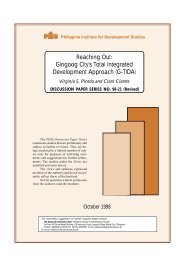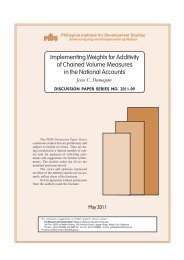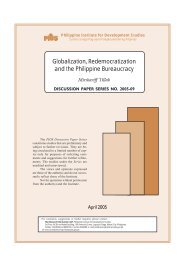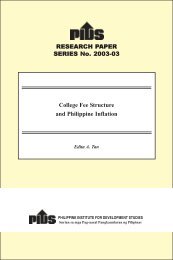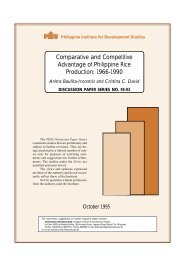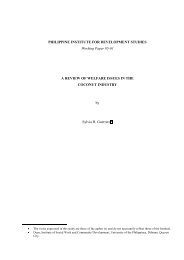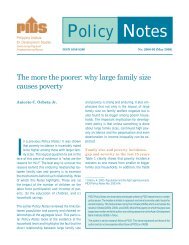Conditional Cash Transfer Program in the Philippines: Is It Reaching ...
Conditional Cash Transfer Program in the Philippines: Is It Reaching ...
Conditional Cash Transfer Program in the Philippines: Is It Reaching ...
You also want an ePaper? Increase the reach of your titles
YUMPU automatically turns print PDFs into web optimized ePapers that Google loves.
poor (those liv<strong>in</strong>g below subsistence level). In 2009, <strong>the</strong>re are about 2 million familiesconsidered to be subsistence poor or those who are extremely poor <strong>the</strong>y could not even afford tomeet <strong>the</strong>ir basic food needs. This amounts to roughly only more than a third of <strong>the</strong> current totalnumber of poor households, at 5.2 million, be<strong>in</strong>g used by <strong>the</strong> 4Ps as its universe of poorhouseholds. In <strong>the</strong> Bolsa Familia of Brazil, <strong>the</strong> difference <strong>in</strong> <strong>the</strong> conditions of <strong>the</strong> poor has beentaken <strong>in</strong>to account when <strong>the</strong>y differentiated <strong>the</strong> amount of transfer given to <strong>the</strong> extremely poorand <strong>the</strong> moderately poor. In Soares, Osorio, Soares, Medeiros, and Zepeda (2007), <strong>the</strong> maximumamount of transfer <strong>in</strong> <strong>the</strong> Bolsa Familia to a family of extreme poverty is roughly $91 PPP permonth for each family while <strong>the</strong> moderately poor receives up to only $42 PPP.Moreover, <strong>the</strong> poor consists of <strong>the</strong> chronically or persistently poor and <strong>the</strong> transient pooror those who become poor because of certa<strong>in</strong> shocks. In fact, more than half (52.6%) of Filip<strong>in</strong>ofamilies who are classified as poor <strong>in</strong> 2009 were transient poor. These are households who aremov<strong>in</strong>g <strong>in</strong> and out of poverty. Only 47.4 percent of poor households <strong>in</strong> 2009 were consistentlypoor s<strong>in</strong>ce 2003 (Reyes, et al., 2011). These two groups have vary<strong>in</strong>g characteristics. Thechronic poor face constra<strong>in</strong>ts that are caused by <strong>the</strong>ir lack of capacity; <strong>the</strong>y are mostlyuneducated and are more likely to perpetuate poverty (i.e. <strong>in</strong>tergenerational poverty) because<strong>the</strong>y could not send <strong>the</strong>ir children to school. Poverty reduction <strong>in</strong>tervention for this group takessusta<strong>in</strong>ed efforts. The transient poor meanwhile are those who become poor dur<strong>in</strong>g certa<strong>in</strong>periods due to economic shocks or natural calamities but may be able to recover when given crop<strong>in</strong>surance, access to credit or emergency employment programs. They have better capacity than<strong>the</strong> chronic poor and <strong>the</strong>ir needs may be <strong>in</strong>termittent. The CCT program, as we know it, normallycaters to <strong>the</strong> chronic poor or <strong>the</strong> extremely poor, as. In <strong>the</strong> target<strong>in</strong>g scheme of <strong>the</strong> 4Ps however,such heterogeneity of <strong>the</strong> poor was not taken <strong>in</strong>to consideration.Size of <strong>the</strong> cash transferIn provid<strong>in</strong>g cash grants, programs also need to account for <strong>the</strong> distance of <strong>the</strong> poor from<strong>the</strong> poverty l<strong>in</strong>e to ensure that <strong>the</strong> amount is of value that would yield an impact. On <strong>the</strong> average,<strong>the</strong> chronic poor’s <strong>in</strong>come has to be augmented by around 5000 pesos per person annually (orabout 32% of <strong>the</strong> poverty threshold) to meet <strong>the</strong> poverty l<strong>in</strong>e based on 2009 <strong>in</strong>come data of <strong>the</strong>chronic poor and 2009 poverty l<strong>in</strong>e. This amount represents <strong>the</strong> <strong>in</strong>come gap of <strong>the</strong> chronic poorfrom <strong>the</strong> poverty l<strong>in</strong>e. The 4Ps provide poor families of five members a maximum amount of15,000 pesos annually (assum<strong>in</strong>g that <strong>the</strong>y have 3 eligible children) or 3,000 per person. Withthis amount, only around a quarter of <strong>the</strong> chronic poor (26%) are able to get out of povertyassum<strong>in</strong>g <strong>the</strong>y do not get exposed to significant economic shocks. Meanwhile, <strong>the</strong> <strong>in</strong>come of <strong>the</strong>transient poor has to be augmented by around 3,400 pesos per person annually. Given <strong>the</strong> actualper capita <strong>in</strong>come of <strong>the</strong> transient poor <strong>in</strong> 2009, <strong>the</strong> 4Ps cash grant can lift only about half of <strong>the</strong>transient poor out of <strong>in</strong>come poverty.9





